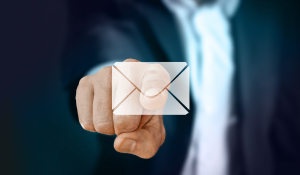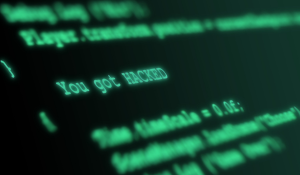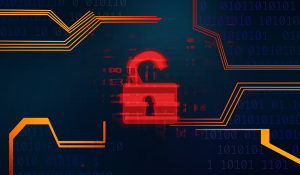The Anatomy Of A Phishing Attack
Among the numerous cyber threats lurking on the horizon, phishing attacks have emerged as a formidable adversary. Like a stealthy predator, these...
11 min read
 DriveLock
Sep 19, 2023 10:07:19 AM
DriveLock
Sep 19, 2023 10:07:19 AM

In the age of digital connectivity, organizations and businesses are more reliant on email communication than ever before. While email serves as a vital tool for collaboration and information exchange, it also presents a potent threat—phishing emails. These deceptive messages lurk in the inboxes of employees, poised to wreak havoc on businesses of all sizes.
| TABLE OF CONTENTS |
Whether you're a small startup or a multinational corporation, the insights shared here will empower you to safeguard your business from the perils of phishing attacks and navigate these treacherous digital waters with confidence.
A phishing email is a type of fraudulent and malicious electronic communication typically sent via email, with the intent to deceive and manipulate recipients into divulging sensitive information, such as personal identification, financial details, login credentials, or other confidential data. These deceptive emails often appear to be from a trustworthy source, such as a legitimate organization, government agency, or well-known company, but they are created by cybercriminals or malicious actors.
The ultimate goal of a phishing email is to deceive individuals into revealing confidential information or performing actions that could lead to financial loss, identity theft, or unauthorized access to their accounts or systems.
When dissecting the anatomy of a phishing attack, two techniques frequently emerge: spoofing and creating a sense of urgency. Spoofing, in the context of email, involves manipulating the 'From' address to mimic a trusted source, such as a colleague or a well-known company. This creates an illusion of legitimacy, making recipients more likely to open the email and follow its instructions. Coupled with this, phishing emails often inject a sense of urgency, claiming immediate action is required to prevent a negative consequence, like account suspension or data loss. This psychological pressure bypasses logical thought, compelling users to click malicious links or provide sensitive data without proper scrutiny. Recognizing these common tactics is a fundamental step in building a robust defense against phishing threats.
Attackers don't rely on technical exploits alone; they masterfully manipulate human psychology. So, how exactly are people targeted? Primarily, they exploit trust and urgency. Fake emails often mimic legitimate communications from banks, online retailers, or even internal company systems, creating a sense of familiarity. They frequently introduce a sense of urgency, such as a 'security alert' or 'account suspension,' pressuring the recipient to act quickly without careful consideration. Attackers also use personalized information gathered from social media or data breaches to craft highly convincing messages. By leveraging these psychological tricks, phishing campaigns bypass traditional security measures and rely on human error to succeed.
A phishing email works by exploiting human psychology and trust to trick recipients into taking actions that benefit the attacker. Phishing attacks rely on the element of surprise, urgency, and trust to manipulate individuals into taking actions they wouldn't ordinarily take. Here's a step-by-step explanation of how a typical phishing email operation works:
1. Setup and Planning:
2. Email Creation:
3. Deceptive Content:
4. Social Engineering:
5. Call to Action:
6. Execution:
7. Outcome:
Phishing attacks can take various forms, each with a specific focus or method of deception. Here are some common types of email phishing attacks, along with descriptions of each:
Spear phishing is a highly targeted form of phishing in which attackers customize their emails for specific individuals or organizations. They often gather personal information about the target to make the email appear more convincing.
Example: An attacker might send a fake email to a company's CEO, impersonating a known business partner and requesting a wire transfer to a fraudulent account.
Clone phishing involves duplicating a legitimate email, making minor modifications (e.g., changing links or attachments), and then sending the forged email from a seemingly trustworthy source.
Example: An attacker duplicates a recent email from a bank, modifies the link to direct recipients to a fake login page, and asks for login credentials.
Whaling is a specific form of spear phishing that targets high-profile individuals, such as CEOs, politicians, or celebrities. Attackers aim to steal sensitive information or compromise their accounts.
Example: An attacker poses as a journalist and sends an email to a celebrity, requesting an interview and asking them to download a "press release" document that contains malware.
Pharming doesn't rely on deceptive emails but manipulates DNS (Domain Name System) settings to redirect users to malicious websites without their knowledge. Users may think they are visiting a legitimate website.
Example: Attackers alter DNS settings to redirect users trying to access a bank's website to a fraudulent site that collects their login credentials.
Vishing, while not an email-based phishing method, vishing involves phone calls or voicemail messages that impersonate trusted entities. It often instructs victims to call a fraudulent number to disclose sensitive information.
Example: Victims receive a voicemail claiming to be from their bank, asking them to call a number to verify their account details.
Smishing is a form of phishing that uses text messages instead of emails. Attackers send SMS messages containing links or phone numbers to trick recipients into providing sensitive information.
Example: Recipients receive a text message claiming they've won a prize and need to click a link to claim it, but the link leads to a phishing website.
Credential Harvesting, this type of fake email typically asks recipients to update or verify their login credentials on a fake website designed to look like a legitimate one.
Example: An email claims that a user's account needs verification due to a security update and provides a link to a counterfeit login page.
Attachment-Based Phishing, phishing emails may contain malicious attachments, such as infected PDFs or Word documents. When opened, these attachments can execute malware on the victim's device.
Example: An email includes an attachment claiming to be an invoice but contains malware that infects the recipient's computer when opened.
Ransomware Phishing, attackers send emails with infected attachments or links that, when activated, download ransomware onto the victim's system, encrypting their files. The victim is then extorted for a ransom to regain access to their data.
Example: A fake email includes a seemingly harmless attachment, but when opened, it infects the victim's computer with ransomware that demands payment for decryption.
Business Email Compromise (BEC) attacks target businesses by impersonating high-ranking executives or trusted vendors to trick employees into performing actions like transferring funds or disclosing sensitive information.
Example: An attacker poses as the CEO and instructs an employee to wire a large sum of money to a fraudulent account, believing it's a legitimate request.
Find out more about different types of cyberattacks:
Recognizing phishing emails is crucial for employees to protect themselves and their organizations from cyber threats. Here are some key strategies and tips that employees of companies can use to identify phishing emails:
Check the Sender's Email Address:
Examine the sender's email address closely. Phishing emails often use slightly altered or deceptive email addresses that mimic legitimate ones.
Look for misspelled domain names, extra characters, or unusual variations.
Inspect the Salutation:
Legitimate organizations usually address recipients by their full name or at least a formal greeting.
Be suspicious of emails with generic greetings like "Dear User" or "Hello Customer."
Beware of Urgency and Threats:
Phishing emails often create a sense of urgency or fear to prompt quick actions.
Watch out for emails that claim your account will be suspended, legal action will be taken, or you will face consequences unless you act immediately.
Examine Spelling and Grammar:
Poor spelling, grammar errors, and awkward language are common in phishing emails.
Carefully read the email for linguistic inconsistencies.
Look for Generic Content:
Phishing emails may use generic or nonspecific content that could apply to anyone.
Be cautious if the email lacks personalized information.
Verify Links and Hover Over Them:
Hover your mouse cursor over any links in the email without clicking. This action will reveal the actual URL that the link points to.
Ensure that the URL matches the legitimate website of the supposed sender.
Check for Unsolicited Attachments:
Avoid opening attachments from unknown or unexpected sources.
Even if the sender is familiar, be cautious if the email requests you to download an attachment you weren't expecting.
Be Wary of Requests for Personal or Financial Information:
Legitimate organizations won't ask you to provide sensitive information like
Social Security numbers, passwords, or credit card details via email.
Don't share such information in response to an email request.
Confirm with the Sender:
If you receive an unexpected email that seems suspicious, contact the sender using a known and trusted method (e.g., phone call or a separate email) to verify the email's authenticity.
Watch for Generic Branding:
Phishing emails may mimic logos and branding of well-known companies, but the quality may be lower or slightly off.
Compare the email's branding with the official website or previous communications from the organization.
Be Cautious of Unsolicited Prize Notifications or Offers:
Be skeptical of emails claiming you've won a prize, lottery, or reward for something you didn't participate in.
Legitimate organizations usually don't give away prizes without your prior knowledge or participation.
Trust Your Instincts:
If something feels off or too good to be true, it likely is. Trust your gut feeling and exercise caution.
Use Anti-Phishing Tools:
Many email clients and security software have built-in anti-phishing features that can help detect and filter out phishing emails.
Employee Training:
Companies should provide regular cybersecurity training to employees to educate them about the latest phishing tactics and how to respond to potential threats.
In this example:
Please note that this is a fictional example, and any resemblance to actual emails is purely coincidental.
Dear [Your Name],
We regret to inform you that your [Bank Name] online banking account is at risk of being suspended due to unusual activity detected on your account. For your security, we require your immediate attention to resolve this issue.
Action Required: Verify Your Account
To verify your account and prevent any potential security breaches, please follow these steps:
1. Click on the link below to access the secure verification page: [Phishing Link: www.fakebankverification.com]
2. Once on the verification page, log in with your online banking credentials.
3. You will be prompted to update your account information, including your Social Security Number, Date of Birth, and ATM PIN for added security.
Failure to complete this verification process within the next 48 hours will result in the suspension of your account, and you will be unable to access your funds or make transactions.
We take your security seriously and apologize for any inconvenience this may cause. Rest assured that your information will remain confidential.
Thank you for your prompt attention to this matter.
Sincerely,
[Scammer's Name] Customer Support Team [Bank Name]
[Contact Information: Phone number and email address]
It's essential to remember that legitimate banks and organizations would never ask customers to provide sensitive information via email. Always verify the sender's authenticity, double-check URLs, and never provide personal or financial information through suspicious emails.
Employee Training and Awareness: Conduct regular cybersecurity training sessions for employees to educate them about phishing risks and best practices. Remember about raising awareness about the latest phishing tactics and provide examples of phishing emails.
Implement Email Authentication Protocols: Use email authentication standards like SPF (Sender Policy Framework), DKIM (DomainKeys Identified Mail), and DMARC (Domain-based Message Authentication, Reporting, and Conformance) to help verify the authenticity of incoming emails.
Email Filtering and Anti-Phishing Software: Employ robust email filtering solutions that can detect and quarantine phishing emails before they reach employees' inboxes. Moreover, utilize anti-phishing software that analyzes email content and attachments for malicious indicators.
Multi-Factor Authentication (MFA): Enforce MFA for access to sensitive systems and accounts. This adds an extra layer of security even if login credentials are compromised.
Secure Email Gateways: Implement secure email gateways (SEGs) to filter out phishing emails, detect malicious links, and prevent them from reaching users.
URL Scanning and Sandboxing: Use URL scanning tools to inspect links in emails for malicious content. Also, employ sandboxing technology to isolate and analyze suspicious email attachments in a safe environment.
Regularly Update and Patch Software: Keep all software, including email clients and operating systems, up to date with the latest security patches to reduce vulnerabilities.
Whitelisting and Blacklisting: Maintain whitelists of trusted senders and domains while blacklisting known malicious sources.
Implement Least Privilege Access: Limit user access to only the resources and systems necessary for their roles. This reduces the potential damage if an account is compromised.
Incident Response Plan: Develop and regularly update an incident response plan that outlines procedures for handling phishing incidents, including communication, containment, and recovery.
Phishing Simulation Exercises: Conduct phishing simulation exercises to test employees' ability to recognize and respond to phishing emails effectively. Provide feedback and additional training based on the results.
Secure Personal Data Handling: Educate employees on the importance of protecting personal data and implementing data handling policies to prevent data leakage in the event of a breach.
Regular Security Audits and Assessments: Conduct regular security audits and assessments to identify vulnerabilities in email systems and processes. Address any weaknesses promptly.
Use Strong Password Policies: Enforce strong password policies, including password complexity requirements and regular password changes.
Encrypt Sensitive Information: Encrypt sensitive email content, especially when transmitting confidential data.
Employee Reporting and Response: Establish clear procedures for employees to report suspicious emails, and ensure that incidents are promptly investigated and mitigated.
Regularly Backup Data: Implement regular data backups and ensure that backups are secure and accessible in the event of a ransomware attack.
Vendor Security Assessments: Assess the security practices of third-party vendors and partners who have access to your organization's email systems or data.
Stay Informed About Phishing Trends: Keep up-to-date with the latest phishing techniques and trends in cybersecurity to adapt your defenses accordingly.
In conclusion, safeguarding your organization against phishing attacks is not a one-time task but an ongoing commitment to cybersecurity. As the digital landscape evolves, so do the tactics employed by cybercriminals. Therefore, it's imperative for organizations to remain vigilant, proactive, and adaptable in the face of these threats.
Remember, a single successful phishing attack can lead to financial losses, data breaches, reputational damage, and regulatory penalties. By following the best practices outlined in this blog post, your organization can significantly reduce its susceptibility to phishing attacks and strengthen its overall security posture.
As phishing attacks continue to evolve, so must our defenses. By staying informed about emerging threats, regularly updating security measures, and fostering a culture of cyber resilience, your organization can stay one step ahead of cybercriminals and minimize the risks associated with phishing emails. Together, we can build a more secure digital future for organizations of all sizes.

Among the numerous cyber threats lurking on the horizon, phishing attacks have emerged as a formidable adversary. Like a stealthy predator, these...

In this relentless digital battlefield, businesses and organizations are pitted against a multitude of adversaries ranging from individual hackers...

The holiday season is a time of joy, giving, and unfortunately, increased cyber threats. As we gear up for festive celebrations, cybercriminals are...